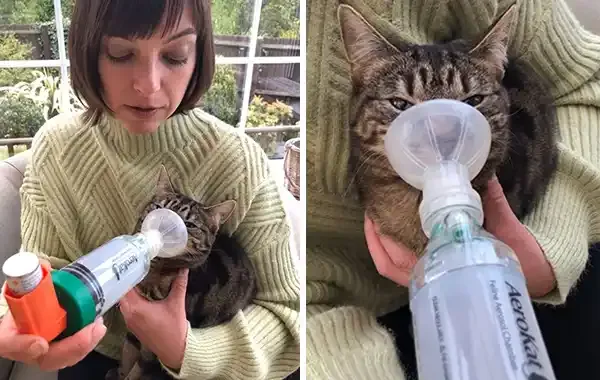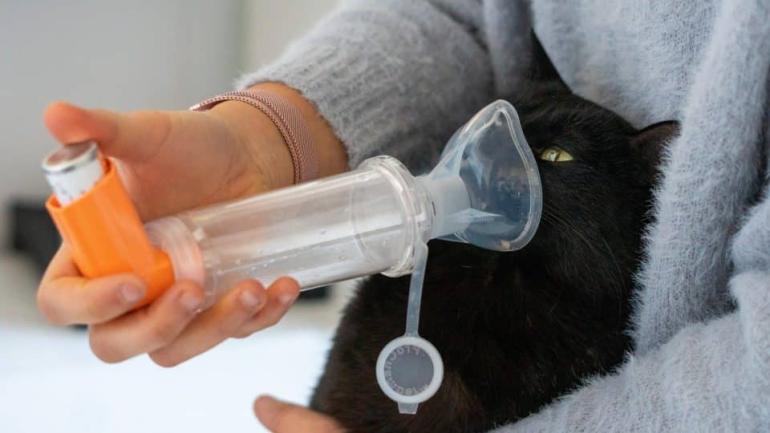Asthma in cats : Understanding the Causes, Symptoms, and Management

Asthma in cats
If your cat has a persistent or chronic cough thay may have asthma. Asthma is the most common cause of coughing in cats. In many cats the signs are relatively mild but it can also cause life-threatening breathing problems.

What is asthma?
Inflammation of the airways in humans without an infectious origin is the cause of asthma. Cats with asthma probably have permanently irritated airways as well. Whether the asthmatic exhibits symptoms of the condition or not, these alterations are there. The lining of the airways may enlarge as a result of the inflammation, and there may be an increase in secretions. The airways get blocked or narrowed as a result of the continuous inflammation.
Causes of Feline Asthma
The exact cause of feline asthma is often unknown, but several factors may contribute to its development:
-
Allergies: Environmental allergens such as pollen, dust mites, mold, and cigarette smoke can trigger asthma attacks in susceptible cats.
-
Genetics: Certain breeds, such as Siamese and Himalayan cats, are more predisposed to asthma.
-
Environmental Factors: Exposure to pollutants, strong odors, and dusty environments can worsen asthma symptoms.
-
Obesity: Overweight cats are at a higher risk of developing asthma.

Why do signs get worse?
A cat with asthma has hyperreactive airways. This indicates that a stimulus that ordinarily wouldn't generate a reaction results in an airway spasm. Pollens or household dust are examples of inhaled particles that might provoke an allergic reaction, as well as irritants like cigarette smoke. Significant airway narrowing results from the interaction of inflammation, excessive secretions, and airway spasm. Cats with constricted airways have less air going into their lungs.
What are the signs of asthma?
The majority of asthmatic cats exhibit dry, ineffective coughing, wheezing, and labored breathing. While a small percentage of cats experience acute asthmatic episodes with an abrupt onset of wheezing and shortness of breath, some cats have a lengthy history of mild coughing. The cat's already restricted airways further collapse, making breathing particularly labored as it tries to exhale. This indicates that air is easily taken into the lungs and gets trapped there. Cats with severe illness may breathe via their mouths.
Symptoms of Feline Asthma
-
Coughing: Persistent coughing, often accompanied by wheezing sounds, is a common symptom of feline asthma.
-
Labored Breathing: Cats with asthma may exhibit rapid or labored breathing, especially during physical activity or rest.
-
Gagging or Vomiting: Asthmatic cats may gag or vomit due to irritation in their airways.
-
Loss of Appetite: Respiratory distress can cause cats to lose interest in food.
-
Lethargy: Cats with asthma may become lethargic and less active than usual.
-
Open-Mouth Breathing: Severe asthma attacks can lead to open-mouth breathing as the cat struggles to breathe.
How will my vet know that my cat has asthma?
A normal history and clinical indications may lead your veterinarian to believe that your cat suffers from feline asthma. To rule out other potential causes of respiratory illness, a number of diagnostic tests must be performed in order to diagnose asthma. Your veterinarian can hear crackles and wheezes when listening to your cat's chest. When their throats are pinched, some affected cats cough, but in others, a physical examination reveals nothing unusual. An asthmatic cat can be diagnosed and evaluated with great benefit via X-rays. Some cats with asthma show normal chest X-rays, even though lung damage may be obvious.
The investigation of airway disease also heavily relies on the collection of respiratory tract samples. To view what's happening within a cat's airways while it's unconscious, a bronchoscope—a flexible tube—can be inserted into the animal's airways. But because cats have extremely narrow airways, it can be challenging to insert a bronchoscope very far into the airways. However, by inserting a catheter further into the airways, your veterinarian will still be able to obtain samples for analysis. Pulmonary function tests are typically used to diagnose asthma in humans (testing how much air can be pushed through the airways). This approach cannot be used in clinical practice for cats due to its practical difficulties.
What can my vet do to help my cat?
Treating cats with modest indications may not be necessary. Medication is necessary for those with moderate to severe illness in order to lessen the intensity and/or frequency of attacks. Since there is no known treatment for feline asthma, long-term therapy is probably required. Your veterinarian might need to transport your cat to the hospital if it is having a severe asthma episode so that it can receive medication injections and more oxygen.
The first step in treating the symptoms is to control the underlying inflammation. Steroid dosages intended to reduce inflammation are typically used. More therapy is often needed to achieve control and reduce the side effects of long-term steroid use. The drugs known as bronchodilators, which open or enlarge the airways, such theophylline, are also beneficial. For humans with asthma, numerous novel medications have been developed, but none of them have received sufficient testing in cats. These new medicines should not be used until the more conventional medications have been thoroughly studied and shown to be insufficient in a specific cat.
Steroids and bronchodilators are examples of inhalational therapy for cats with asthma that have become popular recently. Cats typically receive their inhaled medication through a facemask that is attached to a pediatric "spacer" device. Most cats learn to tolerate these devices well, even if there is a training period involved in their use.
These types of delivery have the following benefits:
- By administering the medication to the right location—the airways—it may be possible to lower the dosage that the body as a whole receives. This is a crucial factor to take into account while using steroids over an extended period of time.
- Long-term tablet administration can be challenging for cats, and many of them find wearing face masks more acceptable. Your veterinarian will demonstrate how to use a spacer if one is provided to you so that you may give your cat medication. Before covering your cat's face with the mask, the dose should be released into the spacer because many cats find the sounds of the dose administration alarming. After that, the cat is given ten seconds or so to breathe multiple times through the mask.
- In addition to invasive therapy, cats with severe asthma may require oral administration of a small amount of steroids. Antibiotics are rarely administered for asthma since bacterial infections are uncommon in the condition.
What can I do to help my cat?
If you know what causes an asthma episode, you should try to keep your cat away from that "trigger." This is rarely possible in real life. Your cat's symptoms may go down if you limit their exposure to irritants including cigarette smoke, gritty cat litter, and aerosol sprays. If your cat is overweight, you should start a weight control program because asthma and obesity have been linked.
Management and Treatment
-
Avoiding Triggers: Identify and minimize your cat's exposure to known triggers, such as smoke, strong scents, and dusty environments.
-
Prescribed Medications: Veterinarians often prescribe bronchodilators and anti-inflammatory medications to manage asthma symptoms. These medications can be administered through inhalers, oral medications, or nebulizers.
-
Weight Management: Maintaining a healthy weight through a balanced diet and regular exercise can help alleviate asthma symptoms, especially in overweight cats.
-
Stress Reduction: Minimize stressors in your cat's environment to prevent anxiety-triggered asthma attacks. Provide a calm and peaceful atmosphere at home.
-
Regular Veterinary Check-ups: Schedule regular check-ups with your veterinarian to monitor your cat's condition and adjust the treatment plan if necessary.
-
Emergency Plan: Have an emergency plan in place in case of severe asthma attacks. Your veterinarian can provide guidance on what to do during emergencies.
Most cats with severe asthma will need lifelong monitoring and intermittent, if not continuous, therapy. Asthma is a chronic condition that is likely to worsen with time. Nonetheless, the majority of cats with asthma can lead fulfilling lives if their condition is properly managed.





